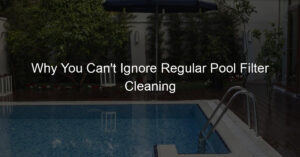Taking a dip in an inground pool can be one of the most refreshing experiences, especially during hot summer days. However, inground pool steps can sometimes develop cracks or leaks, which can not only cause discomfort but can also pose a safety risk. In this article, we will discuss how to repair inground pool steps, the materials you will need, and how to maintain them in the long run.
Understanding your inground pool steps is crucial before embarking on the repair process, as different materials, such as fiberglass, concrete, or vinyl, can require different techniques. It is also essential to identify the issues you need to address, be it cracks, leaks, or structural damage. Adequate preparation, proper tools, and safety precautions are necessary to ensure a successful repair job.
Key Takeaways
- Repairing inground pool steps requires proper understanding and a clear identification of the issues
- Choosing the appropriate materials and techniques is essential for successful step repair
- Pool step maintenance and occasional replacement are key to ensuring the longevity and safety of your inground pool.
Understanding Inground Pool Steps
As a pool owner, I know that inground pool steps are an essential part of my swimming pool. They provide easy access for swimmers to enter and exit the pool. Pool steps come in various materials, such as fiberglass, vinyl, or concrete. Each type of pool step has its own set of unique characteristics, advantages, and maintenance requirements.
For example, fiberglass pool steps are preferred by many due to their smooth surface and relative ease of installation. However, these steps can develop cracks or leaks if not maintained properly. On the other hand, vinyl pool steps are often a part of vinyl-lined in-ground pools. These steps can also experience cracks over time, leading to potential water leaks. Concrete steps, while more durable, can become chipped or cracked and may require more extensive repairs.
Maintenance of inground pool steps is crucial to extend their longevity and performance. Regular cleaning, checking for cracks, and repairing any damages can help in maintaining the quality of these steps. Taking the time to learn about inground pool steps and how to repair them is essential for any pool owner. By understanding and caring for our pool steps, we ensure they remain safe, functional, and long-lasting.
Identifying the Issues
As a pool owner, I’ve noticed that maintaining and repairing inground pool steps is essential for ensuring the safety and longevity of my pool. One of the first things I do is identify the issues. Here’s how I go about it:
I start by inspecting the pool steps for any visible damages like cracks, scratches, or leaks. Cracks are most concerning, as they may cause damage to the pool liner and tend to get worse over time. So, I pay close attention to even the smallest of cracks on the surface as well as the sides and edges of the steps. A cracked pool step should never be ignored, as it may lead to more extensive and costly repairs.
After spotting a crack on my pool step, I make a mental note of its size and location. This helps when it’s time to address the issue. Besides cracks, I also look out for leaks around the steps. Water seeping out from the pool edges or unusual wet spots around the pool area could be a sign of a leak, which may be caused by a damaged step or an issue with the liner.
Another issue I consider in my inspection is identifying scratches and other minor surface damages. While these may not cause immediate concern, they can eventually weaken the step material and allow for the growth of algae, making it slippery and unsafe. Addressing scratches early on helps prevent more significant issues down the road.
In summary, the key to repairing inground pool steps lies in accurately identifying the problems affecting the steps, such as cracks, leaks, or scratches. By quickly spotting and addressing these issues, I ensure my pool remains safe, clean, and enjoyable for years to come.
Materials Required for Repairing
To repair my inground pool steps, I’ll need to gather a few essential materials. First, I’ll need a fiberglass repair kit. This should include everything I need for patching up cracks and reinforcing the repaired area. Additionally, I’ll need some putty and epoxy for filling and sealing the cracks.
Next, I need to have a putty knife or a scraper handy for applying the putty and epoxy. To make sure the repair area is clean and smooth, I mustn’t forget some 100-grit sandpaper and a rotary stone bit to help with smoothing and preparing the surface after scraping away any loose material.
During the repair process, I’ll need masking tape to protect the surrounding area, as well as a dust mask to keep myself from inhaling any particles. Additionally, I should have a towel on hand to dry the repair area completely. However, make sure you’re cautious when using electrical equipment near water.
Once the crack is filled and repaired, I’ll need some epoxy paint to seal the area and blend the repair smoothly with the rest of the pool step. I should choose a paint color that matches or complements the existing color of my pool steps. To apply the paint, I’ll require paint rollers for larger areas and paint brushes for smaller, more precise applications.
Finally, I might need a hose with a water supply nearby to clean up any debris and particles created during the repair process. When it’s time to finish up, it’s essential to clean the area and remove any residue before applying sealant or paint.
With these materials and tools in hand, I should be well-prepared to repair the cracks in my inground pool steps and restore them to their original, safe condition.
Clearing the Pool Step
Before I start repairing my inground pool steps, I need to make sure the pool step area is clean and clear. First, I have to remove the water to get a better look at the cracks and assess the extent of the damage. I attach a hose to my pool’s drain outlet on the filter and carefully direct the water to a safe area of my yard. Once the water level exposes the step cracks, I close the drain valve and turn the filter off.
With the damaged steps exposed, I can now focus on cleaning the steps. Debris, dirt, and algae could interfere with the repair process, so it’s crucial to thoroughly clean and prep the area.
I use a stiff brush with some elbow grease to remove any dirt, algae, or other debris from the steps. If necessary, I can also use a pool vacuum to help get rid of any stubborn debris hiding in the cracks.
Once I’ve ensured that the pool steps are clean, I give the area some time to dry. Proper maintenance is fundamental here, so waiting until the steps are completely dry helps ensure a successful repair. By following these simple steps, I’m creating the ideal conditions to fix my inground pool steps effectively and efficiently.
Repair Processes
I recently learned about repairing inground pool steps, and I’d like to share some important steps and techniques with you. In a friendly manner, of course!
First, let’s talk about the preparation part. Whether you have a vinyl liner, concrete, or fiberglass pool, you’ll need to drain the water below the level of the pool steps so that they are fully exposed. You can use a hose and filter to do this; just be cautious not to flood the surrounding area.
Once the steps are exposed, inspect them for any damage. This is where a repair kit comes in handy, as it offers all the necessary tools for a DIY repair. If your pool steps are made of vinyl, use a vinyl liner repair kit to fix the voids or cracks. However, if your steps are made of fiberglass or concrete, a fiberglass repair kit is your best bet.
Before applying any repair materials, make sure to clean the damaged area thoroughly and remove any debris. Here’s a helpful tip: sand and smooth the surface around the crack or void to ensure better adhesion of the repair material.
Now, let’s talk about the actual repair process. For vinyl liner pool steps, you’ll want to cut a patch from the repair kit slightly larger than the void, then apply an adhesive to both the pool step and the patch. Press the patch firmly onto the damaged area and allow it to cure.
For fiberglass and concrete pool steps, mix the gel from the repair kit according to the instructions. Apply a coat of the gel to the damaged area, followed by a layer of fiberglass cloth. Gently press the cloth into the gel and add a second coat of gel on top. Allow the repair to cure completely before sanding and smoothing the surface.
Remember that repairing your inground pool steps may require some practice, as different materials and techniques are needed for different cases. But with a DIY approach and a friendly demeanor, you can fix those pool steps and enjoy your swimming pool once again. Good luck!
Safety Precautions
Before diving into repairing inground pool steps, I want to remind you of some important safety precautions. Repairing pool steps may involve dealing with chemicals, materials, and tools that can be hazardous if not handled correctly. Therefore, it’s crucial to take the necessary precautions to ensure your safety and the safety of those around you.
Firstly, I advise wearing a mask, especially a dust mask, during the repair process. This helps to protect your respiratory system from potentially harmful particles, like dust or other debris, that might be released during the repair process.
Next, it’s essential to protect your eyes when working with chemicals such as epoxy paint. Wearing appropriate safety goggles can help shield your eyes against possible splashes, spills, or airborne particles. Remember, your eyes are sensitive, and even a minor injury can have lasting consequences.
In addition to your respiratory system and eyes, it’s important to protect your skin when working with chemicals and rough surfaces. Wearing gloves can help prevent skin irritation and potential chemical burns. If you’re working with masking tape to create clean edges during the repair process, gloves also provide a better grip, ensuring the tape adheres properly.
Another important consideration is having proper ventilation when working with chemicals like epoxy paint. Make sure to work in a well-ventilated area, preferably outdoors if possible, to avoid inhaling toxic fumes.
By taking these precautions and being aware of the potential hazards associated with repairing inground pool steps, you can complete the task safely and effectively. Happy repairing!
Final Adjustments
Now that the initial repairing steps have been completed let’s talk about the final adjustments we need to make. These adjustments are crucial to ensure our pool steps not only look good but also remain safe for everyone to use.
First, let’s focus on preparing the surface texture before we paint. After allowing the repaired area to properly dry, I will use sandpaper to sand the surface down, ensuring it is smooth and blends in with the surrounding areas. A smooth surface is essential for the application of paint and epoxy coatings.
Once the surface is smooth, I will clean the area thoroughly to remove any dust or debris from sanding. I will use a cloth soaked in acetone to clean the surface – it works effectively to remove dirt and grease. After cleaning, I will wait for the area to be completely dry.
Now that the surface is prepared, it’s time to apply epoxy paint to the repaired area. I will carefully mix the epoxy paint according to the manufacturer’s instructions. Then, using a brush, I will apply a thin and even layer of paint onto the surface. Applying multiple thin layers will ensure a smoother and more durable finish.
While applying the epoxy paint, it’s essential to maintain a friendly working environment. To speed up the drying process, I may use a hairdryer, holding it 6-12 inches away from the surface, making sure not to overheat or damage the epoxy paint.
Once the paint has fully dried and cured, I will inspect the repaired area to ensure the texture and color blend seamlessly with the surrounding pool steps. If needed, I will apply another layer of paint and repeat the drying process.
By following these steps, I am confident that the inground pool steps will be repaired effectively, ensuring a safe and visually appealing swimming environment for everyone to enjoy. Happy swimming!
Maintaining Pool Steps
As a pool owner, I know it’s important to keep our inground pool steps in the best condition for safety and to prolong their life. Regular pool maintenance plays a crucial role in ensuring your pool steps remain intact and functional for a long time. Let me share some friendly tips with you on how I maintain my pool steps.
Firstly, I make sure to keep the steps free from debris and algae buildup. Using a pool brush regularly, especially on the texture of the steps, helps prevent any slipping hazards for swimmers. A good PVC pool brush is gentle on the surface yet effective in getting rid of grime.
Next, inspecting for wear and tear is essential. Over time, the pool steps may develop cracks or chips due to use and weather exposure. If I notice any damage, I would arrange for a pool repair professional or use a reliable repair kit, depending on the severity. Pool steps can be made from various materials, like fiberglass, vinyl, or concrete. Getting the appropriate repair kit is necessary for a successful DIY repair.
Furthermore, a fresh layer of paint can make a significant difference in maintaining the aesthetics and lifespan of the steps. Using epoxy paint that is specifically designed for pool step applications is my go-to choice. It’s important to follow the manufacturer’s instructions carefully when painting to ensure a long-lasting finish.
Finally, I keep an eye on the pool steps while doing other pool maintenance tasks, such as checking chemical levels and cleaning the filters. It’s crucial to maintain water balance and sanitization in the pool, as it impacts the steps’ longevity.
So, with regular pool maintenance, proper repair, and a little TLC, keeping your inground pool steps in great condition can be achieved. And remember, it’s always best to consult a professional if you’re unsure about any aspect of pool maintenance, repairs, or shipping for parts. Happy swimming!
Pool Step Replacement Options
When it comes to repairing inground pool steps, one option is to replace the steps entirely. As a pool owner, I’ve explored a few different options for step replacements, and I’ll share my discoveries with you in a friendly manner.
First and foremost, the type of pool you have will determine the pool step replacement options available. There are three main types of inground pools: vinyl liner, concrete, and fiberglass.
For vinyl liner pools, the steps can be replaced during a liner replacement. This not only makes the process more convenient, but it can also save on shipping costs for the new steps. The steps for vinyl liner pools are typically made with a steel or polymer frame, which are then covered with the new liner.
In the case of concrete pools, replacing the steps can be more involved as it may require chipping away the existing step and re-pouring it with new concrete. During this process, you might also consider updating the coping around the pool.
Fiberglass pool steps cannot be replaced easily due to their one-piece design. However, cracks and damage can usually be repaired using fiberglass and resin. If the entire fiberglass shell needs to be replaced, it’s best to consult with a professional.
Here are some key options to consider when replacing pool steps:
- Drop-in steps: As a cost-effective option, these steps are easy to install and can work with most inground pool types.
- Integrated steps: These are built into the pool structure itself, offering a seamless look. They are common for concrete and fiberglass pools.
- Custom-built steps: For a personalized touch, these steps can be designed to fit your specific needs and preferences.
Keep in mind that selecting the right materials for your new steps is crucial for ensuring their durability and longevity.
Frequently Asked Questions
How do I fix cracked concrete pool steps?
I usually start by draining the pool water to a level below the cracked step. Then, I clean the cracked area and apply a concrete patching product according to the manufacturer’s instructions. After that, I would smooth the repaired area and allow it to cure before refilling the pool.
What is the process for repairing vinyl pool step liners?
When I have to repair a vinyl liner on a pool step, these are my steps: Drain the water to expose the damaged area, clean the surrounding area, and dry it thoroughly. Then, use a patch kit designed for vinyl liners, following the manufacturer’s instructions. Apply the adhesive and patch, and allow it to set before refilling the pool.
Can I use Flex Seal to fix my pool steps?
Yes, as a temporary solution, I have used Flex Seal to fix small leaks and cracks in pool steps. However, I would recommend using a more durable solution like a professional pool step repair service or specialized repair products for long-term results.
Why do my inground pool steps keep floating?
In my experience, inground pool steps can float if they aren’t properly secured or the water pressure below the steps is too high. To fix this, I would check if there is any water trapped under the steps. If so, drain it and reposition the steps. Additionally, make sure the steps are correctly attached to the pool structure.
How do I replace the inground pool steps?
To replace pool steps, I would follow these general steps: drain the pool water to expose the step area, remove the damaged or old steps according to the manufacturer’s guide, and then install the new steps according to their instructions. Finally, refill the pool and securely attach the new steps to the pool structure.
Is it possible to repair the fiberglass pool steps?
Yes, I have repaired fiberglass pool steps before. First, drain the pool water enough to expose the damaged area. Then, clean and dry the affected area, lightly sand it for better adhesion and apply a fiberglass repair kit following the manufacturer’s instructions. Once the repair has fully cured, you can sand it smooth and paint it to match the pool steps’ color if needed.














